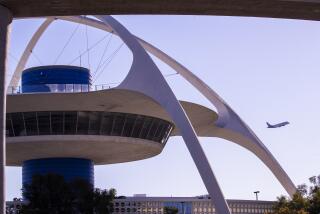The Near-Miss: New Questions, New Fears : FAA Seeks Small Plane Involved in Latest Aeromexico Incident
Federal Aviation Administration officials on Tuesday tried to identify the small plane that was involved in a near-miss with an Aeromexico jetliner north of Cerritos on Saturday and to determine whether the plane had illegally intruded into controlled airspace or was flying just above the restricted area’s ceiling.
Investigators reviewed radar tapes, interviewed air traffic controllers, pored over reports from the Aeromexico crew and listened to recorded conversations between controllers and the crew in a continuing effort to figure out exactly how the two planes missed each other by only a few hundred feet.
While such near-misses are reported as often as once a week in the crowded skies above Los Angeles, Saturday’s incident drew more attention because its circumstances were eerily similar to the Aug. 31 collision between another Aeromexico jet and a light plane over Cerritos that killed 82 people.
Both the crash and the near-miss involved the same route, that of Aeromexico Flight 498 from Mexico City. Both occurred at virtually the same altitude as the jets were approaching Los Angeles International Airport. And in both cases air traffic controllers said they did not see the small plane on their radar screens.
Saturday’s 11:25 a.m. near-miss was reported by Aeromexico pilot German Basanez, whose DC-9 was carrying 40 passengers on the flight’s last leg from Tijuana. Radioing controllers, Basanez said a Cessna 152 had just passed above him by only 300 to 500 feet, far less than the required vertical separation of 1,000 feet.
The incident took place at about 6,200 feet, three to five miles north of the Cerritos crash location. It occurred in a section of restricted airspace where planes must not fly between 4,000 and 7,000 feet unless they have proper altitude-reporting equipment and permission from controllers.
Investigators Tuesday declined to quote the jet pilot’s description of the Cessna’s path. They said their own review of computer tapes of radar information, which would show the path, had not been completed.
Because the Aeromexico pilot was not able to provide the Cessna’s tail identification number or colors, it is possible that the FAA will never locate the other pilot, FAA spokesman Russell Park said.
The agency’s best hope, Park said, may be persuading the pilot of the small plane to come forward voluntarily.
FAA officials said they are no longer positive that the Cessna violated the Terminal Control Area (TCA), a 52-by-24-mile swath of sky set aside primarily for jets taking off and landing at Los Angeles International Airport.
Park said that although the Aeromexico pilot reported his altitude at 6,200 feet when he radioed news of the near-miss, his jet’s altitude at the time of the incident was probably somewhat higher because the pilot was descending.
Since the Aeromexico jet reported that the Cessna passed 300 to 500 feet overhead, that means that the small plane may have been above the TCA’s 7,000-foot ceiling, Park said.
Pilots have complained for years that the restricted area’s boundary lines are convoluted and extremely difficult to interpret. “It’s often hard for a pilot to judge exactly where he is--and whether he’s in a TCA,” said John Galipault, director of the Aviation Safety Institute in Worthington, Ohio.
Park said the small plane apparently was not equipped with a transponder, a device that enhances radar detection. “We didn’t see it on radar originally (on the screen) . . . but it may show up on the tapes,” he said.
Last December, at National Transportation Safety Board hearings on the cause of the Cerritos crash, the question of why the controller who tracked the Aeromexico jet did not see the small plane was a major issue. Computer tapes of radar signals indicated that radar had tracked the small plane. However, there was conflicting testimony on whether FAA computers could reliably transmit all such signals to a controller’s screen.
According to a controller at the Los Angeles Terminal Radar Control Center, who spoke on condition that his name not be used, the radar and communications equipment used to track Saturday’s Aeromexico flight and other traffic approaching and leaving Los Angeles apparently was functioning normally at the time of the near-miss. The controller said that the colleague who was responsible for Aeromexico Flight 498 on Saturday relayed the near-miss reported by the pilot and asked if any of the other controllers had seen the light plane, but none had.
Since the Cerritos crash, there have been 30 reported violations of the Los Angeles Terminal Control Area. These violations--and many more that were not noticed by FAA air traffic controllers--took place despite an FAA campaign to convince private pilots to respect airspace boundaries.
In the wake of the Cerritos crash, the FAA assembled a team of 30 in-house experts to examine TCAs. Last October the team issued a list of 40 recommendations, designed essentially to improve separation between the aircraft that operate under FAA control within the air spaces and aircraft not under FAA control that are supposed to operate outside of them.
One key proposal called for a standardized design for the TCAs at the nation’s 23 busiest airports, with each reshaped into a roughly circular configuration. The air space at Los Angeles currently is irregular in shape, consisting of a collection of 12 wedge-shaped segments.
Locally, the FAA’s Western Pacific Region vowed to improve safety among private pilots by holding more safety seminars and sending inspectors to local airports to “counsel” pilots before they take off.
“They hit it real hard after Cerritos,” said Paul Stebelton, accident prevention specialist in the FAA’s Long Beach office. But he said the effort has diminished in recent months.
More to Read
Sign up for Essential California
The most important California stories and recommendations in your inbox every morning.
You may occasionally receive promotional content from the Los Angeles Times.










